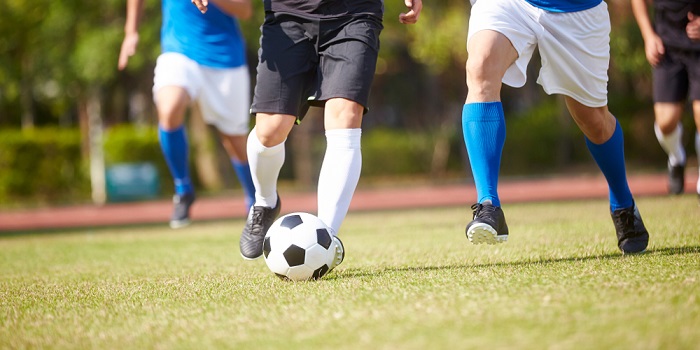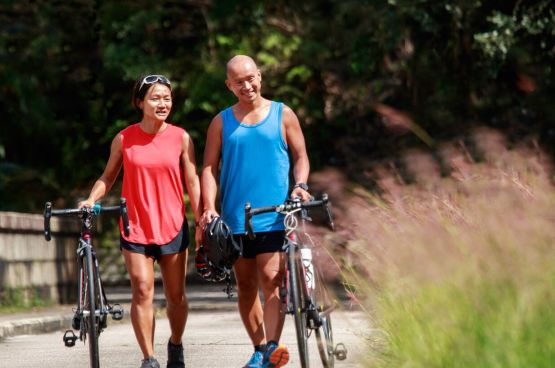Common football injuries and how to manage them
Football is a fast, high-energy sport and injuries are common. Whether you play yourself or have a child who loves the game, it helps to know what to do when injuries happen.
Here, I’ll explain some of the most common football injuries and how to manage them. I’ll also share my top tips for avoiding an injury in the first place.

What are the most common football injuries?
You’re more likely to become injured during a competitive match than during training sessions. You might get a football injury from:
- tackling
- running
- twisting or turning
- jumping or landing
- using the same muscles repeatedly (overuse/fatigue)
- hurting an area you’ve injured before if it’s weak (re-injury)
- foul play or colliding with an opponent
- lack of physical conditioning (doing ‘too much too soon’)
So, it’s no surprise that the most common football injuries tend to affect your lower body. These include:
- a sprained ankle
- anterior cruciate ligament (ACL) injury
- hamstring strains
- groin strains
- knee injuries
It’s also common to injure your wrist and hand, or to get a concussion (when you injure your head) from playing football. This article focuses on injuries that affect your lower body.
Sprained ankle
When you play football, you’re often running on an uneven surface and sometimes have to change direction at a moment’s notice. This could cause your ankle to roll inwards or outwards, and the ligaments that stabilise your ankle joint could become overstretched.
How to manage a sprained ankle
If you sprain your ankle, you should follow the POLICE procedure. This stands for:
- Protect
- Optimal loading
- Ice
- Compression
- Elevation
Bupa's POLICE infographic (PDF, 0.5 MB), illustrates the ‘POLICE principles’ to reduce your pain and help you to recover.
Things you should avoid
There are also certain things you should avoid in the first three days after your injury so you don’t damage your ankle further. These can be remembered as HARM.- Heat
- Alcohol
- Running
- Massage
Bupa's HARM infographic (PDF, 0.6 MB), illustrates the ‘HARM principle' of things you should avoid doing in the first three days after your injury.
Hamstring strain
Your hamstrings are the three large and powerful muscles at the back of your thigh. They produce a driving force during acceleration when you run.
Playing football often involves quick changes of pace, going from standstill to quick speed in just a couple of seconds. If your hamstrings don’t have enough length (from stretching) or strength, they can become overloaded, which could cause a strain.
How to manage a hamstring strain
If you strain your hamstring, follow the POLICE and HARM steps, as above.
To help prevent a hamstring injury, make sure to stretch regularly and use a foam roller. A foam roller is a cylindrical device you use to massage and relieve sore and tight muscles.
It can also help to strengthen your hamstring muscles. Regularly do some strength training exercises such as deadlifts, leg curls, and hamstring bridges, as well as some sport-specific speed drills.
Groin strain
When you’re on the pitch, kicking, twisting, running, or jumping could injure your inner thigh muscles (also known as your adductors). This is commonly known as a groin strain.
How to manage a groin strain
As with most strains, follow the POLICE and HARM steps above. To help prevent a groin strain from football, be sure to stretch your inner thighs regularly. Also include strengthening exercises, such as adductor side bridges and side lunges in your exercise routine.
Anterior cruciate ligament (ACL) injury
Your ACL is a very important stabilising ligament in your knee. It’s commonly injured if your lower leg stays planted while the upper part of your leg twists or moves. For example, during a tackle or when landing a jump while in motion.
While a full tear to your ACL would most likely need surgery, a sprain to your ACL can usually be managed with physiotherapy and rehabilitation.
How to manage an ACL strain
If you injure your knee, follow POLICE and HARM steps. If it’s still painful and swollen after several days, it’s important to seek advice from a physiotherapist. They can assess how badly you’ve damaged your ACL and give you advice on the type of treatment you might need.
Other football injuries
Other possible injuries from football include:
- Achilles tendinopathy
- posterior cruciate ligament (PCL) injury
- calf strain
- meniscal injuries
- shin splints
- quadriceps strain
If you become injured while playing football, it’s best to take it easy and allow your body to rest for at least a few days. Follow the steps in POLICE and HARM for the first couple of days.
If your symptoms continue, see a physiotherapist. They will be able to give you a full assessment and help with your recovery. They can also give you exercises to strengthen your muscles, which may prevent you getting a similar injury in the future.
Top tips for preventing football injuries
Here are my top tips for looking after your body and preventing injury. This advice can apply to all sports – not just football.
1. Strengthen your lower limbs
Away from the pitch, do some lower limb strengthening exercises. This will help to make sure your major muscle groups are prepared to cope with the demand of a football game. These could include calf raises, squats, lunges, and deadlifts.
2. Warm up
Taking just a few minutes to warm up properly before playing football will prepare your body for exercise and reduce your risk of injury. Do some dynamic stretching (stretching while moving, such as leg swings and knees up) alongside some jogging to increase blood flow to your muscles. Add in some ball drills that involve changing direction and speed.
3. Cool down
Spend a bit of time after the game cooling down to help reduce your risk of future injury. Spend around 10 minutes doing some low-intensity cardiovascular exercise and stretch all your lower limbs thoroughly.
4. Wear the right gear
Protect your body by wearing the right type of clothing. It’s worth getting fitted with some good boots and wearing shin guards too. If you’re training outdoors, protect your skin from the sun by using a sunscreen with at least SPF30 and a star rating of 5.
5. Eat a healthy diet
Stay hydrated and eat the right foods to help fuel your body during exercise and to help recover afterwards.
6. Get enough rest
Be sure to get plenty of rest in between training and matches. This gives your body the time it needs to repair. If you’re feeling any pain, listen to your body and take a bit of time out to recuperate. It’s better to miss one match than to end up injured and out of action for weeks or even months.
If you have a muscle, bone or joint problem, our direct access service aims to provide you with the advice, support and treatment you need as quickly as possible. If you’re covered by your health insurance, you’ll be able to get advice from a physiotherapist usually without the need for a GP referral. Learn more today.
-
Sources Sources
- Ankle sprains. MSD Manuals. www.msdmanuals.com, last reviewed July 2023
- Sprains and strains. NICE Clinical Knowledge Summaries. cks.nice.org.uk, last revised September 2020
- Hamstring Strain. MSD Manuals. www.msdmanuals.com, last reviewed November 2023
- Wiewelhove T, Döweling A, Schneider C et al. A meta-analysis of the effects of foam rolling on performance and recovery. Front Physiol 2019; 10:376. doi: 10.3389/fphys.2019.00376
- Adductor strain. StatPearls. www.statpearls.com, last updated December 2023
- Anterior Cruciate Ligament Injury. Medscape. emedicine.medscape.com, last updated October 2024
- Overview of exercise. MSD Manuals. www.msdmanuals.com, published 26 October 2021
- Abade E, Sampaio J, Gonçalves B et al. Effects of different re-warm up activities in football players' performance. PLoS One 2017; 12(6):e0180152. doi: 10.1371/journal.pone.0180152
About our health information
At Bupa we produce a wealth of free health information for you and your family. This is because we believe that trustworthy information is essential in helping you make better decisions about your health and wellbeing.
Our information has been awarded the PIF TICK for trustworthy health information. It also follows the principles of the The Information Standard.

More exercise and fitness articles
Did you find our advice helpful?
We’d love to hear what you think. Our short survey takes just a few minutes to complete and helps us to keep improving our healthy lifestyle articles.
Legal disclaimer
This information was published by Bupa's Health Content Team and is based on reputable sources of medical evidence. It has been reviewed by appropriate medical or clinical professionals and deemed accurate on the date of review. Photos are only for illustrative purposes and do not reflect every presentation of a condition.
Any information about a treatment or procedure is generic, and does not necessarily describe that treatment or procedure as delivered by Bupa or its associated providers.
The information contained on this page and in any third party websites referred to on this page is not intended nor implied to be a substitute for professional medical advice nor is it intended to be for medical diagnosis or treatment. Third party websites are not owned or controlled by Bupa and any individual may be able to access and post messages on them. Bupa is not responsible for the content or availability of these third party websites. We do not accept advertising on this page.







